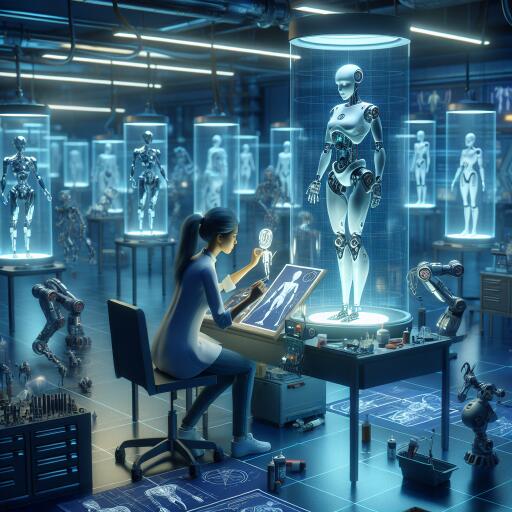The Future of Personalized Robotics
The advancements in robotics over recent years are steadily bringing the vision of robots accomplishing complex tasks as personal assistants and essential partners in human interactions closer to reality. A significant leap has been made by the German Research Center for Artificial Intelligence (DFKI) as part of the M-Rock project, which is financially supported by the German Federal Ministry of Education and Research (BMBF). Employing groundbreaking hybrid AI techniques and insightful human feedback, these innovations have notably enhanced the safety and adaptability of robotic behaviors.
Robots as Versatile AI Assistants
The growing trend of digitalization, coupled with robust hardware and AI-driven data processing, is setting the stage for robots to serve as the adaptable and reliable AI assistants of tomorrow. They will need to seamlessly adjust to diverse environments and perform various tasks in fields such as manufacturing, logistics, healthcare, or even in everyday scenarios. However, their widespread acceptance will significantly rely on the ability to customize them according to individual preferences and needs. Here lies the role of M-Rock, designed as an extension of the X-Rock developments from the DFKI Robotics Innovation Center, which builds upon the successes of the previous D-Rock and Q-Rock initiatives. The overarching aim of X-Rock is to enable individuals, regardless of their expertise level, to design bespoke robots suited for their specific applications.
Human Feedback Integration in Robotics
Though D-Rock primarily focused on creating an extensive database of modular robotic components, Q-Rock pioneered automatic alignment of complex hardware-software architectures to specific robotic tasks, using hybrid AI frameworks like machine learning and structural reasoning. The M-Rock initiative takes this a step further by embedding human feedback, not just to tailor robotic behavior according to user demands on the software side, but also to pave the way for refining behavior and hardware choice subsequently. This advancement offers a dynamic solution for the ongoing adaptation of robots, providing a gateway for personalized robotic design and function.
The Role of Explicit and Implicit Feedback
M-Rock’s remarkable innovation lies in merging explicit feedback methods, such as scale ratings, with implicit feedback such as brain and muscle activity (recorded as EEG and EMG data), allowing robots to adapt to the user’s unique needs and wants. A deep dive into the effectiveness of human feedback involved four detailed studies where EEG data were collected as test subjects observed robotic errors and human-induced errors. The resulting data was scrutinized for the error-related potential, a response invoked within the brain when errors are recognized.
Further studies gathered both types of feedback, highlighting scenarios like perceiving faults in a worn elbow orthosis and observing missteps in a pendulum robot. The EEG data analysis revealed high precision in detecting error-related potentials, underscoring that implicit feedback can be effectively utilized to detect real-time errors, whether arising in robotic functions, human movements, or orthotic devices. This detection capability empowers the system to autonomously make adjustments, appreciating the user’s input without needing heavy involvement from their side.
Optimal Cognitive Cores: A Leap Forward
An additional triumph of the M-Rock project is the enhancement of Cognitive Cores (CCs) from the Q-Rock phase, developing them into Optimal Cognitive Cores (OCCs) through the employment of optimal control strategies. These OCCs facilitate the production and execution of natural robotic behaviors for complex setups, elevating human-robot interaction by precisely articulating robotic tasks. By factoring in elements such as energy consumption, timing, and safety, OCCs utilize mathematical models to deduce optimal resolutions to intricate control challenges. Instances involving the RH5 humanoid robot validated the use of OCCs in crafting walking and dancing motions, adding a layer of fluidity and grace to robotic movement.
Refining the performance of these Optimal Cognitive Cores through human feedback is pivotal. It aids in crafting cost functions instrumental in planning the best possible trajectories, guiding robots through efficient movements characterized by human assessments. This creates a responsive robotic system ready to adapt to evolving, dynamic environments.
Evaluating Breakthroughs in Application Scenarios
The technology stemming from M-Rock was rigorously evaluated in two key scenarios. The first scenario explored an “assist-as-needed” model for an exoskeleton offering personalized robotic aid to users based on individual CE (Central Energy) data. EMG data reflected muscle activity, guiding a neural network in predicting joint forces during diverse arm movements performed by the subjects. The findings illuminated how the exoskeleton could assess user competencies based on EMG readings, delivering tailored support for each joint movement.
The second scenario focused on harmonizing behavioral traits and design parameters in a quadruped robot capable of impressive feats like jumping and backflips. OCCs played an essential role in modulating this quadruped’s movements precisely for specific tasks and in pinpointing the optimal morphology. Tests with the real system advocated for specific design enhancements, such as elongated upper legs for forward motions and extended lower legs for effective backward somersaults.
The academic output from this project is substantial, with over 30 publications, encompassing doctoral dissertations, articles in leading journals, and presentations at high-profile robotics conferences worldwide, evidencing the profound impact and feasibility of these innovations.
The M-Rock initiative, running from August 2021 to July 2024 through project code 01IW21002, is thoroughly backed by the German Federal Ministry of Education and Research, marking a significant milestone in the journey toward personalized advanced robotics, powered by human-centric AI solutions.
Images related to this project are available for download, provided that the copyright is acknowledged, allowing a further glimpse into the innovative world of M-Rock.










